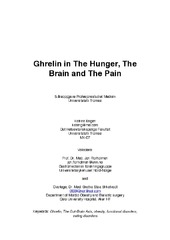| dc.contributor.advisor | Florholmen, Jon | |
| dc.contributor.advisor | Birketvedt, Grete Støa | |
| dc.contributor.author | Engen, Katrine | |
| dc.date.accessioned | 2013-03-27T11:02:56Z | en |
| dc.date.accessioned | 2014-02-06T11:48:46Z | |
| dc.date.available | 2014-02-06T11:48:46Z | |
| dc.date.issued | 2012-06-01 | |
| dc.description.abstract | Bakgrunn
Oppgaven er en litteraturstudie som sammenfatter det siste tiårets forskning på nevrohormonet ghrelin, innenfor en holistisk forståelse av The Gut Brain Axis som et felles fysiologisk spektrum for flere ulike følelser, som sult, metthet og smerte.
Mål med studien
Å presentere en litterær oversikt over ghrelin med vekt på hvordan hormonet er integrert i The Gut Brain Axis, og hvordan det er involvert i vektregulering, sult, spiseatferd, funksjonelle tilstander og inflammasjon.
Material og metode
Søk i PubMed og Cohrane databasen
Resultat
Ghrelin stimulerer sult og appetitt. Det er også en ligand til veksthormonfrisettende reseptor GHS-R1a, og en promoter av motilitet i magesekken. Det er en negativ assosiasjon mellom ghrelin og BMI, så vel som insulin og insulinfølsomhet. Forstyrrelser i vekt, spiseatferd og inflammatoriske tilstander kjennetegnes av endringer i ghrelinsekresjonen, og en forstyrret relasjon mellom de molekylære formene av hormonet.
Konklusjon
Virkningene av ghrelin bør sees innen en holistisk forståelse av The Gut Brain Axis. Videre forskning på ghrelin bør vurdere begge molekylære former av hormonet. | en |
| dc.description.abstract | Background
This paper is a literary review of the past ten years of research on the neuropeptide hormone ghrelin, with a holistic understanding of The Gut Brain Axis as a common physiological spectrum for several sensations, such as hunger, satiety and pain.
Aim of study
To present a literary review of ghrelin with emphasize on how it is integrated in the gut-brain axis, and how it is involved in weight regulation, hunger, eating behavior, functional conditions and inflammation.
Materials and Methods
Searches in PubMed and The Cochrane Library.
Results
Ghrelin stimulates hunger and appetite. It is also a ligand for the growth hormone-releasing receptor GHS-R1a, and a promoter of gastric motility. There is a negative correlation between ghrelin and BMI, as well as insulin and insulin sensitivity. Distortions of weight, eating behavior and inflammatory conditions are characterized by changes in ghrelin secretion, and a disturbed relation of the molecular forms.
Conclusion
The effects of ghrelin should be seen within a holistic understanding of The Gut Brain Axis. Clinical trials in the years to come should consider both molecular forms of ghrelin. | en |
| dc.identifier.uri | https://hdl.handle.net/10037/5821 | |
| dc.identifier.urn | URN:NBN:no-uit_munin_5515 | |
| dc.language.iso | eng | en |
| dc.publisher | Universitetet i Tromsø | en |
| dc.publisher | University of Tromsø | en |
| dc.rights.accessRights | openAccess | |
| dc.rights.holder | Copyright 2012 The Author(s) | |
| dc.rights.uri | https://creativecommons.org/licenses/by-nc-sa/3.0 | en_US |
| dc.rights | Attribution-NonCommercial-ShareAlike 3.0 Unported (CC BY-NC-SA 3.0) | en_US |
| dc.subject.courseID | 5.-årsoppgave | en_US |
| dc.subject | VDP::Medical disciplines: 700::Clinical medical disciplines: 750::Endocrinology: 774 | en |
| dc.subject | VDP::Medisinske Fag: 700::Klinisk medisinske fag: 750::Endokrinologi: 774 | en |
| dc.subject | Nevroendokrinologi | en |
| dc.title | Ghrelin in the hunger : the brain and the pain | en |
| dc.type | Master thesis | en |
| dc.type | Mastergradsoppgave | en |


 English
English norsk
norsk
